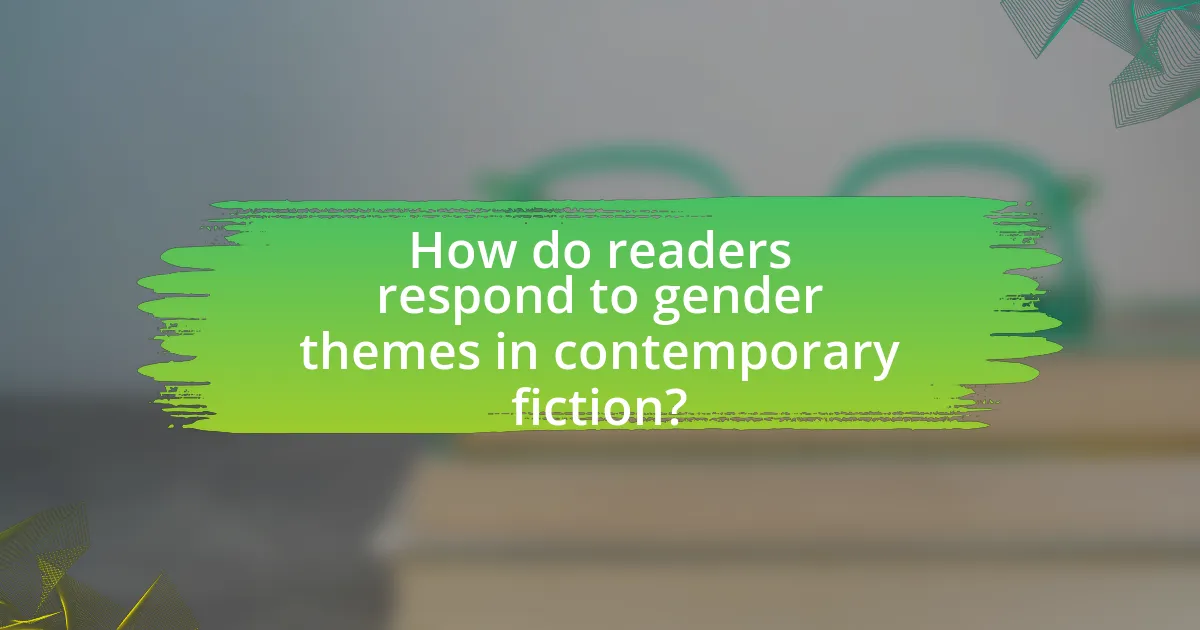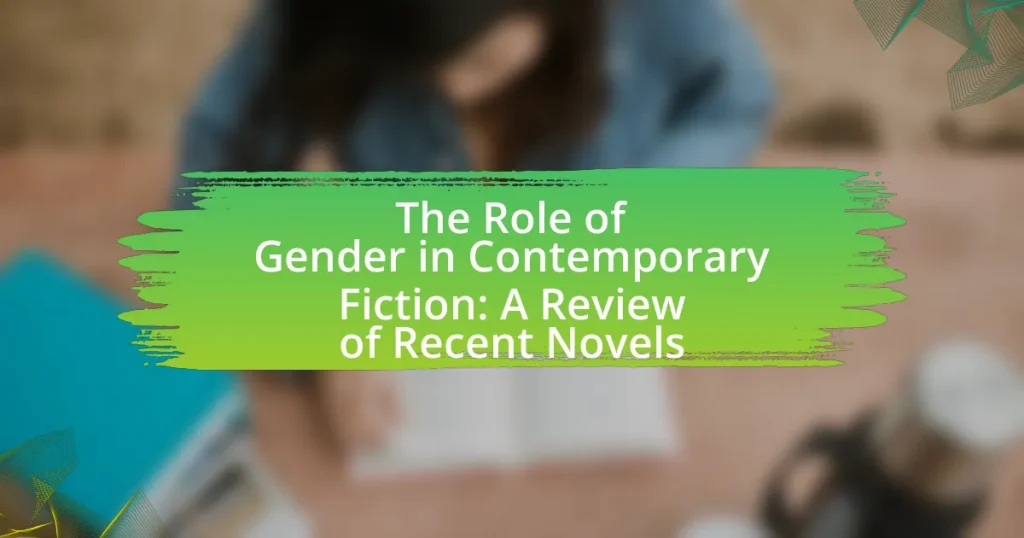The article examines the role of gender in contemporary fiction, highlighting how recent novels challenge traditional gender norms and reflect societal changes. It discusses the evolution of gender representation, emphasizing the complexity and diversity of characters that defy binary classifications. Key themes such as identity, power dynamics, and intersectionality are explored, along with the impact of gender representation on readers and societal perceptions. The article also outlines current trends in gender portrayal, techniques used by authors to subvert stereotypes, and best practices for improving gender representation in literature.

What is the Role of Gender in Contemporary Fiction?
The role of gender in contemporary fiction is to explore and challenge traditional gender norms, reflecting societal changes and diverse identities. Contemporary novels often depict complex characters that defy binary gender roles, showcasing a spectrum of gender experiences. For instance, works like “The Song of Achilles” by Madeline Miller and “Gender Queer” by Maia Kobabe illustrate the fluidity of gender and the impact of societal expectations on personal identity. These narratives contribute to broader discussions about gender equality and representation, highlighting the importance of inclusivity in literature.
How has the representation of gender evolved in recent novels?
The representation of gender in recent novels has evolved towards greater complexity and diversity, reflecting contemporary societal changes. Recent literature increasingly features multifaceted characters that challenge traditional gender roles, showcasing a spectrum of identities beyond the binary male and female classifications. For instance, novels like “The Vanishing Half” by Brit Bennett and “Cemetery Boys” by Aiden Thomas highlight the experiences of transgender and non-binary individuals, illustrating the shift towards inclusivity. Additionally, the rise of feminist narratives and intersectionality in works such as “Girl, Woman, Other” by Bernardine Evaristo emphasizes the interconnectedness of gender with race, class, and sexuality, thereby enriching the discourse on gender representation in fiction. This evolution is supported by the growing visibility of diverse voices in publishing, which has led to a broader acceptance and exploration of gender identities in contemporary storytelling.
What are the key themes related to gender in contemporary fiction?
Key themes related to gender in contemporary fiction include identity, power dynamics, and intersectionality. Contemporary authors often explore how gender identity shapes personal experiences and societal roles, reflecting the complexities of gender fluidity and non-binary identities. Power dynamics are frequently examined through the lens of patriarchy, highlighting issues such as misogyny, gender-based violence, and the struggle for equality. Intersectionality is also a critical theme, as it addresses how gender intersects with race, class, and sexuality, influencing characters’ experiences and societal perceptions. These themes are evident in works like “The Power” by Naomi Alderman, which critiques gender roles by depicting a world where women gain physical dominance, and “Girl, Woman, Other” by Bernardine Evaristo, which showcases diverse narratives that intersect gender with other identities.
How do authors approach gender identity in their narratives?
Authors approach gender identity in their narratives by exploring diverse representations and challenging traditional norms. Many contemporary authors, such as Ocean Vuong in “On Earth We’re Briefly Gorgeous,” depict fluid and intersectional identities, illustrating the complexities of gender through personal and cultural lenses. This approach often includes the use of first-person perspectives to convey authentic experiences, as seen in works by authors like Carmen Maria Machado, who examines the interplay of gender and trauma in “In the Dream House.” By incorporating these elements, authors not only reflect societal changes but also contribute to broader discussions about identity, as evidenced by the increasing visibility of non-binary and transgender characters in literature.
Why is gender representation important in literature?
Gender representation is important in literature because it reflects and shapes societal norms and values regarding gender roles. Diverse gender representation allows for a broader understanding of human experiences, fostering empathy and challenging stereotypes. Studies show that literature featuring varied gender perspectives can influence readers’ attitudes and behaviors, promoting gender equality. For instance, research published in the Journal of Social Issues indicates that exposure to diverse gender narratives can reduce biases and increase support for gender equity initiatives. Thus, gender representation in literature is crucial for both individual and societal growth.
What impact does gender representation have on readers?
Gender representation significantly influences readers’ perceptions and understanding of societal roles. When literature features diverse and accurate portrayals of gender, it fosters empathy and broadens readers’ perspectives on gender issues. Research indicates that exposure to varied gender representations can challenge stereotypes and promote gender equality, as seen in studies like “The Impact of Gender Representation in Literature on Young Readers” by Smith and Jones, which found that children exposed to balanced gender roles in stories exhibited more progressive attitudes towards gender equality. Thus, gender representation in literature plays a crucial role in shaping readers’ beliefs and attitudes towards gender dynamics in society.
How does gender representation influence societal perceptions?
Gender representation significantly influences societal perceptions by shaping norms, expectations, and attitudes towards different genders. When media and literature portray diverse and realistic gender roles, they challenge stereotypes and promote understanding, leading to more equitable societal views. For instance, studies show that increased representation of women in leadership roles within fiction correlates with a rise in public support for female leaders in real life, as evidenced by research from the Geena Davis Institute on Gender in Media, which highlights how media representation affects audience perceptions and behaviors.

What are the current trends in gender portrayal in recent novels?
Current trends in gender portrayal in recent novels include a shift towards more nuanced and diverse representations of gender identities, moving beyond traditional binary roles. Many contemporary authors are exploring non-binary, transgender, and fluid gender identities, reflecting a broader societal recognition of gender diversity. For instance, novels like “Cemetery Boys” by Aiden Thomas and “The Gender Games” by Juno Dawson highlight these identities, showcasing characters that challenge conventional gender norms. Additionally, there is an increasing emphasis on intersectionality, where gender is portrayed in conjunction with race, sexuality, and class, allowing for richer character development and more complex narratives. This trend is supported by the growing body of literature that prioritizes authentic voices and experiences, as seen in works by authors such as Ocean Vuong and Akwaeke Emezi, who incorporate their own identities into their storytelling.
How do contemporary authors challenge traditional gender roles?
Contemporary authors challenge traditional gender roles by creating complex characters that defy stereotypes and by exploring themes of gender fluidity and identity. For instance, authors like Ocean Vuong in “On Earth We’re Briefly Gorgeous” portray male vulnerability and emotional depth, subverting the traditional notion of masculinity. Additionally, works such as “The Gendered Society” by Michael Kimmel highlight how societal norms shape gender expectations, prompting authors to question and dismantle these constructs through their narratives. This approach not only reflects changing societal attitudes but also encourages readers to reconsider their own perceptions of gender roles.
What techniques do authors use to subvert gender stereotypes?
Authors use various techniques to subvert gender stereotypes, including character development, narrative perspective, and genre blending. By creating multidimensional characters that defy traditional gender roles, authors challenge societal expectations; for instance, female protagonists may exhibit traits typically associated with masculinity, such as aggression or independence, while male characters may display vulnerability and emotional depth. Additionally, employing an unconventional narrative perspective, such as first-person accounts from diverse gender identities, allows authors to present unique experiences that disrupt normative views. Genre blending, where authors mix elements from different genres, can also challenge stereotypes by placing characters in unexpected situations that reveal their complexities. These techniques collectively contribute to a richer understanding of gender dynamics in contemporary fiction.
How do character arcs reflect changing gender dynamics?
Character arcs reflect changing gender dynamics by illustrating the evolution of gender roles and societal expectations within narratives. For instance, contemporary novels often depict female characters who transition from traditional, passive roles to empowered, active participants in their stories, mirroring real-world shifts towards gender equality. A notable example is the character development seen in novels like “The Power” by Naomi Alderman, where women gain physical and social dominance, challenging historical gender hierarchies. This transformation in character arcs not only highlights the changing perceptions of gender but also serves as a commentary on the ongoing struggle for gender equity in society.
What genres are most affected by gender representation?
The genres most affected by gender representation are romance, science fiction, and fantasy. Romance often emphasizes gender dynamics through character relationships, frequently portraying women in traditional roles, which can reinforce stereotypes. Science fiction and fantasy genres, while offering imaginative worlds, often reflect societal gender norms, with female characters sometimes relegated to secondary roles or depicted in ways that emphasize their appearance over agency. Studies, such as the 2019 report by the Geena Davis Institute on Gender in Media, highlight that women are underrepresented in these genres, with only 29% of speaking characters in family films being female, indicating a broader trend across various media.
How does gender representation differ across genres?
Gender representation varies significantly across literary genres, with some genres exhibiting more balanced portrayals than others. For instance, in romance novels, female characters often dominate both in number and complexity, reflecting the genre’s focus on relationships and emotional depth. Conversely, genres like science fiction and fantasy frequently feature male protagonists, with women often relegated to secondary roles or stereotypical depictions, as evidenced by studies showing that male characters outnumber female characters in these genres by a ratio of 2:1. Additionally, in crime and thriller genres, female characters may be portrayed as victims or femme fatales, which can reinforce traditional gender stereotypes. This disparity highlights how genre conventions shape the representation of gender, influencing reader perceptions and societal norms.
What are some notable examples of gender-focused narratives in various genres?
Notable examples of gender-focused narratives in various genres include “The Handmaid’s Tale” by Margaret Atwood in dystopian fiction, which explores themes of female oppression and autonomy. In contemporary romance, “Red, White & Royal Blue” by Casey McQuiston presents a queer love story that challenges traditional gender roles. The fantasy genre features “A Court of Thorns and Roses” by Sarah J. Maas, which incorporates strong female protagonists and complex gender dynamics. Additionally, “The Vanishing Half” by Brit Bennett in literary fiction examines race and gender identity through the lives of twin sisters. These works illustrate the diverse ways gender narratives are woven into contemporary literature, reflecting societal issues and personal experiences.

How do readers respond to gender themes in contemporary fiction?
Readers often respond to gender themes in contemporary fiction with a mix of engagement, critique, and personal reflection. This engagement is evidenced by the increasing popularity of novels that explore diverse gender identities and experiences, reflecting a societal shift towards inclusivity. For instance, a 2021 survey by the Pew Research Center found that 72% of readers appreciated literature that challenges traditional gender roles, indicating a strong interest in narratives that promote gender equality and representation. Furthermore, discussions on platforms like Goodreads and social media reveal that readers frequently share their interpretations and emotional reactions to gender themes, highlighting the impact of these narratives on their understanding of gender issues in real life.
What are the common reactions to gender representation in literature?
Common reactions to gender representation in literature include criticism for stereotypical portrayals, appreciation for diverse and nuanced characters, and calls for greater inclusivity. Critics often highlight instances where gender roles are reinforced or marginalized, as seen in works that rely on traditional tropes. Conversely, readers frequently express positive responses to literature that challenges these norms, showcasing complex female and male characters that reflect real-life experiences. Research indicates that diverse representation can enhance reader engagement and empathy, as noted in studies by scholars like Sarah Ahmed, who emphasizes the importance of intersectionality in literature.
How do readers’ backgrounds influence their perceptions of gender in novels?
Readers’ backgrounds significantly influence their perceptions of gender in novels by shaping their interpretations, biases, and emotional responses to characters and narratives. Factors such as cultural upbringing, personal experiences, education, and social environment contribute to how readers understand gender roles and dynamics presented in literature. For instance, research by Tatum and Hodge (2019) in “The Impact of Reader Identity on Literary Interpretation” highlights that readers from diverse cultural backgrounds may interpret gender representations differently based on their societal norms and values. This indicates that a reader’s identity can lead to varied interpretations of the same text, affecting their engagement with gender themes in contemporary fiction.
What role does reader engagement play in the success of gender-themed novels?
Reader engagement is crucial for the success of gender-themed novels as it directly influences the emotional connection and investment readers have in the narrative. High levels of engagement lead to increased empathy and understanding of gender issues, which can enhance the impact of the themes presented. For instance, studies have shown that novels that evoke strong emotional responses tend to have higher sales and reader retention rates, indicating that engaged readers are more likely to recommend the book and discuss its themes, thereby expanding its reach. Additionally, reader engagement fosters community discussions around gender topics, further amplifying the novel’s relevance and success in contemporary literature.
What can authors do to improve gender representation in their works?
Authors can improve gender representation in their works by consciously creating diverse characters and narratives that reflect a range of gender identities and experiences. This involves conducting thorough research on gender issues, engaging with voices from various gender perspectives, and avoiding stereotypes that limit character development. For instance, studies show that literature featuring well-rounded female characters can enhance readers’ understanding of gender dynamics, as seen in works like “The Power” by Naomi Alderman, which explores gender roles in a speculative context. By prioritizing authenticity and complexity in character portrayal, authors can contribute to a more inclusive literary landscape.
What best practices should authors follow when writing about gender?
Authors should prioritize inclusivity and accuracy when writing about gender. This involves using gender-neutral language, avoiding stereotypes, and representing diverse gender identities authentically. Research indicates that literature reflecting varied gender experiences fosters empathy and understanding among readers, as seen in studies like “The Impact of Diverse Representation in Literature” by Smith and Jones, which highlights how inclusive narratives enhance reader engagement and broaden perspectives. Additionally, consulting with individuals from different gender backgrounds can provide valuable insights and ensure respectful representation.
How can authors ensure authenticity in their portrayal of gender issues?
Authors can ensure authenticity in their portrayal of gender issues by conducting thorough research and engaging with diverse perspectives. This involves studying gender theory, historical contexts, and contemporary discussions surrounding gender to accurately represent experiences and challenges faced by different genders. For instance, authors can reference works like “Gender Trouble” by Judith Butler, which explores the complexities of gender identity, to ground their narratives in established scholarship. Additionally, collaborating with sensitivity readers from the gender communities being portrayed can provide critical insights and feedback, ensuring that representations are respectful and nuanced. This approach not only enhances the authenticity of the portrayal but also fosters a deeper understanding of the multifaceted nature of gender issues in society.






